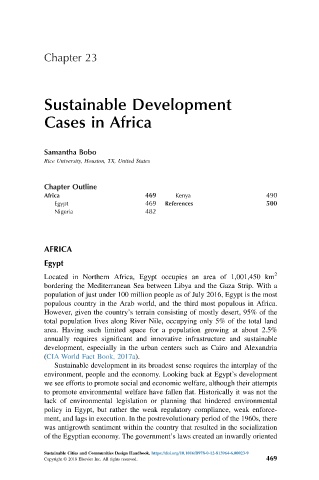Page 499 - Sustainable Cities and Communities Design Handbook
P. 499
Chapter 23
Sustainable Development
Cases in Africa
Samantha Bobo
Rice University, Houston, TX, United States
Chapter Outline
Africa 469 Kenya 490
Egypt 469 References 500
Nigeria 482
AFRICA
Egypt
Located in Northern Africa, Egypt occupies an area of 1,001,450 km 2
bordering the Mediterranean Sea between Libya and the Gaza Strip. With a
population of just under 100 million people as of July 2016, Egypt is the most
populous country in the Arab world, and the third most populous in Africa.
However, given the country’s terrain consisting of mostly desert, 95% of the
total population lives along River Nile, occupying only 5% of the total land
area. Having such limited space for a population growing at about 2.5%
annually requires significant and innovative infrastructure and sustainable
development, especially in the urban centers such as Cairo and Alexandria
(CIA World Fact Book, 2017a).
Sustainable development in its broadest sense requires the interplay of the
environment, people and the economy. Looking back at Egypt’s development
we see efforts to promote social and economic welfare, although their attempts
to promote environmental welfare have fallen flat. Historically it was not the
lack of environmental legislation or planning that hindered environmental
policy in Egypt, but rather the weak regulatory compliance, weak enforce-
ment, and lags in execution. In the postrevolutionary period of the 1960s, there
was antigrowth sentiment within the country that resulted in the socialization
of the Egyptian economy. The government’s laws created an inwardly oriented
Sustainable Cities and Communities Design Handbook. https://doi.org/10.1016/B978-0-12-813964-6.00023-9
Copyright © 2018 Elsevier Inc. All rights reserved. 469

